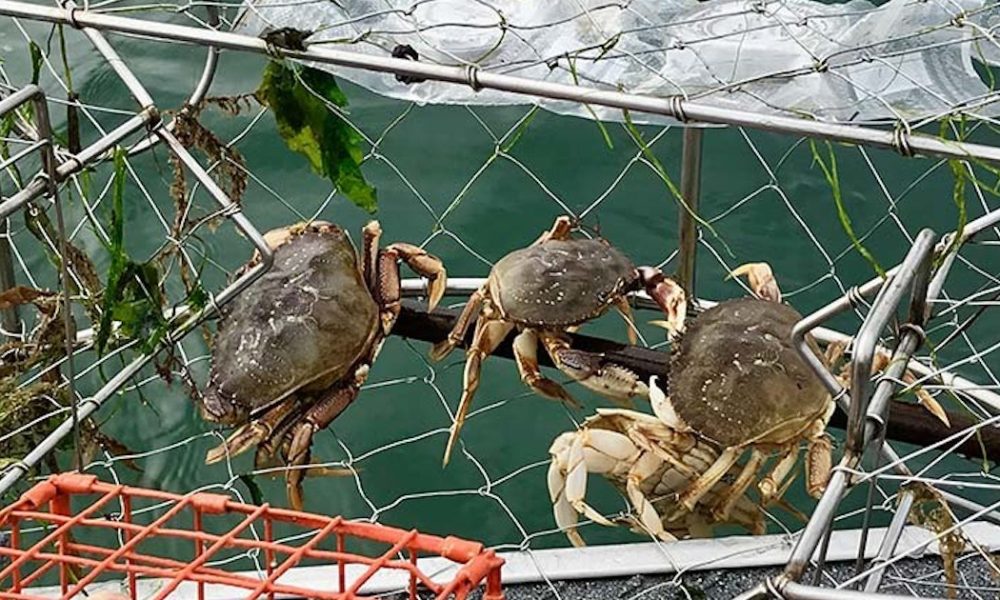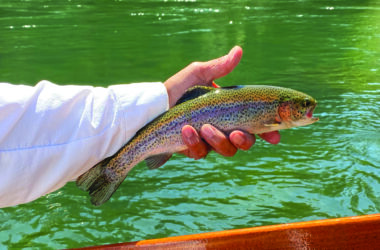 A few crabs in the trap can take the sting out of a fishless day trolling. These are from the lower Siuslaw bay. We did better over Labor Day weekend up at Newport, where we dropped traps outside the harbor before heading out to troll salmon. FRANK ARMENDARIZ
A few crabs in the trap can take the sting out of a fishless day trolling. These are from the lower Siuslaw bay. We did better over Labor Day weekend up at Newport, where we dropped traps outside the harbor before heading out to troll salmon. FRANK ARMENDARIZ
A popular saying among Oregonians is, ”If you don’t like the weather (or do like it, for that matter), just wait a minute and it will change.” That is pretty much what happened last week as a series of weather fronts began to sweep across our state and county. As I assemble this report, moderate rainfall has fallen for most of Sunday on my Florence home.
Though generally on the weak side, the cold fronts have stirred up conditions enough to depress some fisheries, particularly among warm-water sunfish species. The warm-water fishing will likely become hit-and-miss over the next several weeks before completely fading away for the season in October. No one can complain about the bass fishing this summer. With world-class water like Siltcoos Lake it is becoming one of the premier angling opportunities in Lane County. Bass fishing will pick up again next spring in early April.
On the other hand, the change in the weather was a hopeful sign to salmon fishermen, including those on the Siuslaw River. More fall salmon will move into the bays and estuaries along the Oregon coast, where bay fishing has only been fair this season. Water temperatures in the bays are still running a bit high, right now in the low 60-degree range. A slight cool-down and a little more rain could move the catching meter from only fair into the good range. With no retention of wild coho allowed in the bays this year and only stray hatchery coho that occasionally enter the Siuslaw, the Siuslaw fishery is a ”Chinook Show” and a few fish in the upper 30-pound range have already been caught this year.
For anglers able to boat outside the breakwaters, the salmon fishing, chinook and coho are holding up pretty well in the last days of summer. Opened on the Aug. 31-Sept. 1 weekend, the non-selective season for coho produced about 5,500 coho caught of the 9,000-fish quota, in the Cape Falcon to California border zone.
Speculation was that Sept. 7 or 8 would have been the end of the non-selective coho season. But at a Wednesday, Sept. 4 fisheries meeting, a provision in coho management rules allowed the ODFW to roll forward some of the summer numbers of uncaught ocean coho, adding them to the current quota and increasing the allotment to 15,600 fish. As a result, the ocean non-selective coho season will continue each weekend in September or until the quota has been met. Let’s hope for ocean conditions that will allow us to venture into the sea.
I fished with my good friend and Cabela’s pro staff angler Jim Martin on the ocean out of Newport on the first weekend of the non-selective season. It was a ”first time out of Newport” for me and only Jim’s second trip.
We had the right gear, Jim’s 20-foot Willie and good baits, but we were poking around in the dark, so to speak. About a mile out we found 145 to 170 feet of water and were marking fish on Jim’s fishfinder. But trolling herring at 35 feet only produced a single three-pound coho jack for us – which made a decent lunch but other than that was not much to brag about.
We had the ocean depth correct, but turns out successful salmon anglers that weekend were trolling at about 45 to 50 feet and those boats averaged about one salmon per angler. Lesson learned: the biting fish were a little deeper; always next time….
There was a major development in the local fishing world that I need to mention here. Thanks to the Oregon Legislature, which realized the importance of the Leaburg Fish Hatchery to the economy of the McKenzie River Valley and Governor Brown, who signed the bill, hatchery fish production has returned, for now, to Leaburg Hatchery on the McKenzie River.
Also last week, as mitigation for lost habitat, the US Army Corps of Engineers signed a contract to have the Oregon Department of Fish & Wildlife raise fish at Leaburg to stock into the McKenzie River and other water bodies in the southern Willamette Valley. Summer steelhead production will also return to Leaburg this fall.
For the past couple seasons, hatchery fish planted in the McKenzie were raised in the ideal, springfed, 60-degree water of the Desert Springs Trout Farm near Summer Lake, Oregon. Generally a good quality hatchery fish, when released into the cold McKenzie, where water temperatures seldom reach 58 degrees, the Desert Springs trout proved to be far less resilient and were very poor biters. Stressed, they often died when released back into the river after being caught.
We know from creel census that about a third of the anglers on the McKenzie are catch-and-release anglers, which highlights another layer of the Desert Springs fish incompatibility with the McKenzie River. The fishing in the McKenzie should be much better next spring.
Now, go fishing! Take your kids or a friend. Those days will become some of your best memories.
You can contact Frank at [email protected].
The perfect river levels
http://www.rivertrailoutfitters.com/contact.html








